I’ve tackled my fair share of woodworking projects, from patching up old furniture to fixing weathered outdoor railings, and let me tell you, Bondo Wood Filler has become my go-to for getting the job done right.
It’s not just about filling holes—it’s about creating a seamless, durable repair that stands up to time and wear. Whether you’re a DIY newbie or a seasoned carpenter, Bondo’s reliability makes it a must-have.
Trust me, once you try it, you’ll wonder why you ever bothered with anything else. Let’s explore why this product is a game-changer.
My Experience With Bondo Wood Filler
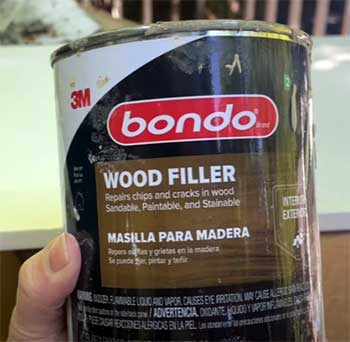
I first stumbled across Bondo Wood Filler when I was restoring an old oak table that had seen better days.
The surface was riddled with deep scratches, and one leg had a chunk missing from a run-in with a rogue lawnmower.
I’ll admit, I was skeptical. I’d heard Bondo was originally for auto body repairs, so I wasn’t sure how it’d perform on wood.
But I was desperate for something that could handle serious damage without falling apart after a season.
Mixing Bondo was my first surprise. It comes as a two-part system: a thick, grayish filler and a red cream hardener. You scoop out a bit of filler, add a small amount of hardener (I learned quickly to stick to a 1:3 ratio), and mix it on a scrap piece of cardboard.
The stuff starts setting fast—within a few minutes—so you’ve got to work quickly. I used a plastic putty knife to apply it, smoothing it into the table’s scratches and rebuilding the missing chunk on the leg. It felt like sculpting, which was oddly satisfying.
After about 15 minutes, the filler was hard enough to sand. I grabbed some 80-grit sandpaper and went to town, shaping the repaired areas. The texture was solid, almost like real wood, and didn’t crumble like some other fillers I’d tried.
Once sanded smooth, I painted the table, and you’d never know it had been damaged. The repair held up through a year of outdoor use, even with rain and heat. That’s when I knew Bondo wasn’t just hype—it was a lifesaver for my projects.
The smell, though? Yeah, it’s intense, like a chemical workshop. I made the mistake of using it indoors the first time, and my garage smelled like a mechanic’s shop for days. Ventilation is non-negotiable.
But that minor hassle aside, the durability and speed of Bondo made it worth it. I’ve since used it on everything from window frames to a rotted fence post, and it’s never let me down.
Pros of Bondo Wood Filler
- Lightning-Fast Drying Time
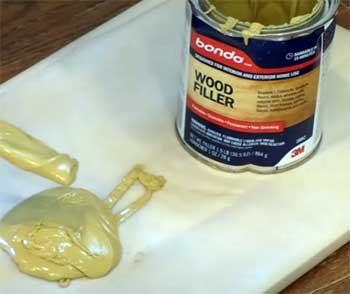
One of the things I love about Bondo is how quickly it gets the job done.
You mix it, apply it, and in about 15 minutes, you’re ready to sand.
For someone like me, who’s always juggling multiple projects, this is a huge win.
Most wood fillers take hours to dry, especially for deeper repairs, but Bondo lets you keep moving.
It’s perfect for those moments when you’re racing against a deadline or just impatient to see the final result.
- Rock-Solid Durability
Bondo doesn’t mess around when it comes to strength. Once it hardens, it’s like a concrete patch for your wood. I’ve used it on outdoor projects exposed to rain, heat, and freezing winters, and it holds up without cracking or shrinking.
For example, I repaired a deck railing that was practically crumbling, and two years later, it’s still solid. This durability makes it ideal for high-traffic areas or pieces that need to withstand wear and tear.
- Versatility for Big Repairs
Whether you’re filling a tiny nail hole or rebuilding a chunk of missing wood, Bondo can handle it. Its thick, moldable consistency lets you sculpt it into whatever shape you need.
I’ve used it to reconstruct corners of furniture and fill deep gouges in hardwood floors, and it never feels like a compromise. Unlike some fillers that are only good for shallow fixes, Bondo’s strength makes it a go-to for serious structural repairs.
- Paintable Finish
If you’re planning to paint over your repair, Bondo’s your friend. It sands down to a smooth surface that takes paint like a dream. I’ve painted over Bondo repairs on furniture and exterior trim, and the finish looks flawless every time.
Just make sure to sand it well and prime it first to get that seamless look. It’s not always the best for staining, but for painted projects, it’s hard to beat.
Cons of Bondo Wood Filler
- Strong Odor
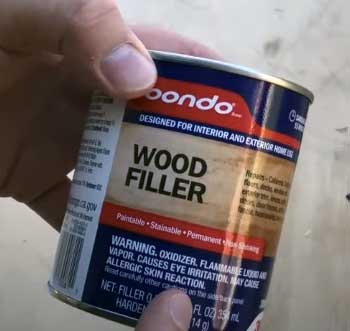
Let’s not sugarcoat it—Bondo stinks. The chemical smell hits you the moment you open the can, and it lingers.
I made the mistake of using it in my basement once, and I had to open every window and run fans to clear the air.
If you’re working indoors, you’ll need serious ventilation, and even then, it’s not pleasant.
For outdoor projects, it’s less of an issue, but you’ll still want a mask if you’re sensitive to fumes.
- Tricky Mixing Process
Mixing Bondo is an art form. You’ve got to get the ratio of filler to hardener just right, or you’ll end up with a gooey mess that won’t set properly. Too much hardener, and it hardens before you can apply it; too little, and it stays tacky.
I’ve wasted a few batches figuring this out, and it can be frustrating if you’re new to two-part fillers. Practice on small amounts first to get the hang of it.
- Limited Stainability
If you’re hoping for a perfect stain match, Bondo might disappoint. It doesn’t absorb stain the same way wood does, often resulting in a slightly off color. I tried staining a Bondo repair on an oak table, and the patch looked darker and less natural than the surrounding wood.
For stained projects, you’ll need to test it first or consider painting instead. This is a big drawback if your project demands a natural wood look.
- Not Ideal for Small Repairs
For tiny nail holes or superficial scratches, Bondo can feel like overkill. Its fast-setting nature means you’re racing against the clock, which isn’t ideal for delicate work.
I’ve found it’s better suited for larger repairs where you can take advantage of its strength and moldability. For small fixes, I often reach for something simpler, like a premixed putty, to save time and hassle.
Maintenance Tips For Bondo Wood Filler
- Proper Surface Preparation
Before you even think about mixing Bondo, prep your surface like your project depends on it—because it does. I always start by cleaning the area thoroughly, removing dirt, grease, or loose wood. For rotted wood, dig out all the soft, mushy bits until you hit solid material.
I’ve found that applying a wood hardener first can strengthen the base, especially for outdoor repairs. Sand the area with 80-grit sandpaper to give Bondo something to grip onto.
Trust me, skipping this step leads to repairs that peel or crack later.
- Mix in Small Batches
Bondo sets fast, so don’t mix more than you can use in a couple of minutes. I learned this the hard way when I mixed a big batch and ended up with a hardened lump before I could apply it all.
Use a small scoop of filler and a dab of hardener, mixing on a disposable surface like cardboard. A chopstick or small dowel works great for blending it evenly. This keeps waste to a minimum and gives you enough working time to apply it smoothly.
- Apply in Thin Layers
For deep repairs, resist the urge to fill everything in one go. Bondo cures better in thin layers, usually about 1/8 inch at a time. I’ve tried packing a deep hole all at once, and the center stayed soft for days. Instead, apply a layer, let it harden for 15-20 minutes, then add another.
This ensures a solid, crack-free repair. Smooth each layer with a putty knife to reduce sanding later.
- Sand and Prime for a Flawless Finish
Once Bondo is dry, sanding is your best friend. Start with 80-grit sandpaper to shape the repair, then move to 120-grit or finer for a smooth finish. I always wipe away dust with a damp cloth before priming. A good primer seals the filler and preps it for paint.
If you’re staining, test a small area first, as Bondo’s stain absorption can be unpredictable. For outdoor projects, seal with an exterior-grade paint or sealant to protect against moisture.
- Store Properly to Extend Shelf Life
Bondo’s tight-lock container is a lifesaver, but you’ve still got to store it right. Keep it in a cool, dry place, and make sure the lid is sealed tightly after each use. I’ve had tubs last over a year without drying out.
If the hardener starts running low, buy extra separately—the small tube in the combo kit won’t last as long as the filler. Trust me, you don’t want to be stuck mid-project with no hardener.
Comparison of Bondo Wood Filler With Other Fillers
- Gorilla Wood Filler

Gorilla Wood Filler caught my attention with its promise of a smooth, natural finish, and it mostly delivers.
The texture is thick but spreadable, almost like gritty peanut butter, which makes it easy to push into larger holes.
I used it to patch a chipped chair leg, and it filled the gap effortlessly without needing a second coat.
It dries in about 15-30 minutes, depending on the thickness, which is fast but not quite as quick as Bondo.
Sanding was a breeze, and it took paint well, giving a seamless look.
The natural finish blends decently with wood grain, and it’s stainable, though I noticed a slight greenish undertone that made the stain darker than expected. Unlike Bondo, it’s water-based, so the smell is minimal, which is a huge plus for indoor work.
However, it’s not as durable for heavy-duty repairs. I used it on an outdoor bench, and after a year, I noticed some cracking where Bondo would’ve held firm. It’s great for small to medium fixes, but for structural repairs, Bondo’s strength wins out.
- DAP Plastic Wood Filler
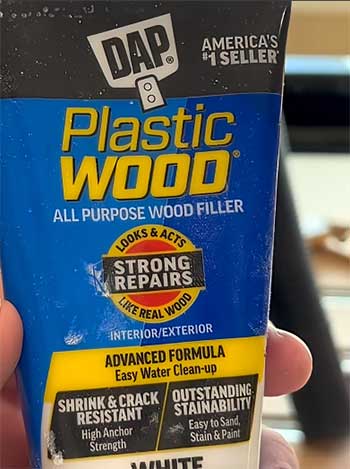
DAP Plastic Wood Filler is a crowd favorite for its ease of use, and I get why.
It’s a solvent-based filler with a putty-like consistency that goes on smoothly, especially for small holes.
I tried it on some nail holes in a pine bookshelf, and it was a dream to apply—no mixing required, just scoop and spread.
It dries in about an hour for shallow repairs, though deeper fills can take longer, which is slower than Bondo.
The color-changing formula (pink to natural) is handy for knowing when it’s ready to sand.
It sands smoothly and takes paint beautifully, but staining was hit-or-miss. On oak, it left a slightly discolored patch that I couldn’t sand out.
The smell is noticeable but not as harsh as Bondo’s, making it more indoor-friendly. However, it’s not as tough as Bondo for larger repairs. I used DAP on a window frame, and it shrank slightly after a few months, something Bondo avoids.
For quick, small fixes, DAP’s simplicity is hard to beat, but it doesn’t match Bondo’s durability.
- Minwax Stainable Wood Filler
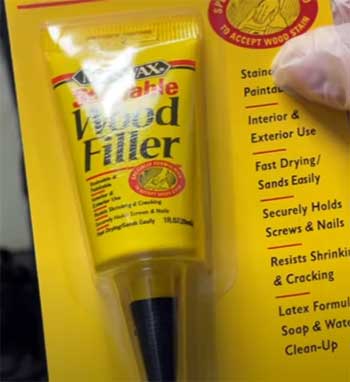
Minwax Stainable Wood Filler is a heavy hitter for projects where staining is the goal.
Its water-based formula has real wood fibers, giving it a grainy texture that feels closer to actual wood.
I used it to fill screw holes in an oak cabinet, and it spread easily with a putty knife, drying in about 2-6 hours depending on depth.
Sanding was straightforward, and it held stain better than Bondo, closely matching the wood’s color on oak.
For painted projects, it’s solid too, though I needed a primer to get a perfectly smooth finish. The downside? It’s not as strong as Bondo for structural repairs. I tried it on a rotted porch post, and it cracked after a wet season, where Bondo would’ve stood strong.
It’s also slower to dry and can shrink slightly in deeper applications, which Bondo avoids. The lack of odor is a big win for indoor use, but for heavy-duty or outdoor projects, Bondo’s toughness outshines Minwax’s versatility.
Frequently Asked Questions (FAQ)
Bondo is fantastic for certain jobs, especially if you need a durable, fast-drying solution for larger repairs. I’ve used it to rebuild furniture corners and patch rotted wood, and it’s held up where other fillers failed. Its strength and quick 15-minute drying time make it a go-to for structural fixes. However, the strong smell and tricky mixing process can be a hassle, and it’s not great for staining. If you’re painting or need a rock-solid repair, it’s hard to beat, but for small, stainable fixes, you might want something simpler.
Absolutely, Bondo is a champ for repairing rotted wood. I’ve used it on fence posts and window frames where rot had taken hold. The key is to remove all the soft, damaged wood first—dig it out until you hit solid material. Applying a wood hardener before the filler helps create a stable base. Bondo’s thick consistency lets you rebuild the missing areas, and once it hardens, it’s tougher than the original wood. Just make sure to seal it with paint or an exterior-grade sealant for outdoor use to keep moisture out.
Picking the “best” wood filler depends on your project. Bondo is my pick for durability and speed, especially for large or outdoor repairs. Its strength is unmatched, but the odor and staining issues are drawbacks. Minwax Stainable Wood Filler is better for projects where a natural, stained finish is key, though it’s less durable. DAP Plastic Wood Filler shines for small, easy fixes with minimal fuss, but it can shrink. Gorilla Wood Filler is a solid middle ground for versatility and ease, but it’s not as tough as Bondo. For me, Bondo wins for heavy-duty tasks.
Bondo is one of the fastest fillers out there. After mixing, it starts setting within 3-5 minutes, so you need to apply it quickly. It’s hard enough to sand in about 15 minutes for small repairs, though deeper fills might take up to 30 minutes to fully cure. I’ve found it’s ready for painting or further shaping within an hour, which is a lifesaver for quick projects. Just don’t dawdle during application, or you’ll end up with a hardened blob you can’t use.
Final Thoughts On Bondo Wood Filler
Bondo Wood Filler isn’t just another product—it’s a problem-solver that’s saved me time and frustration on countless projects. From rebuilding furniture to patching rotted wood, it delivers durability and speed that few competitors can match.
If you’re ready to tackle your next woodworking challenge with confidence, grab a can of Bondo. It’s the kind of tool that makes you feel like a pro, even if you’re just starting out.
Keep it in your toolbox, and you’ll be ready for anything wood throws your way.
